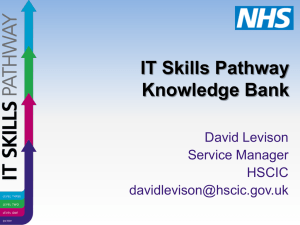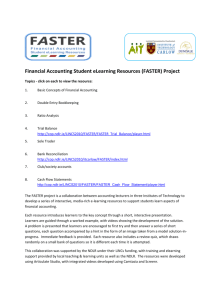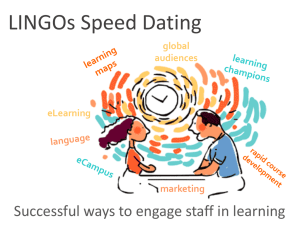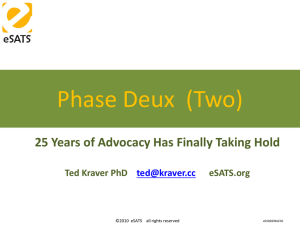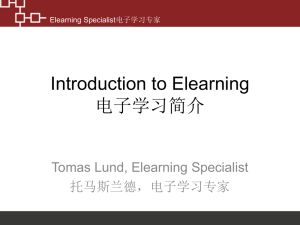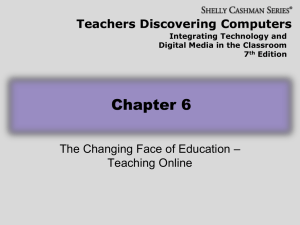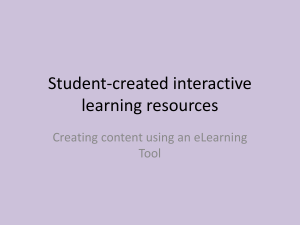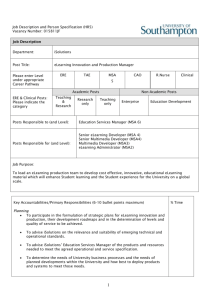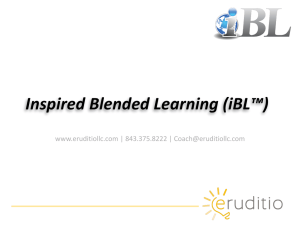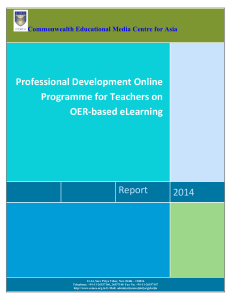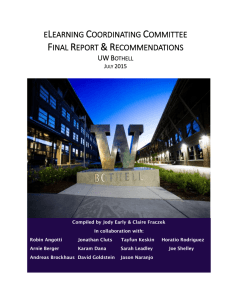Draft_v3_cb_160310
advertisement
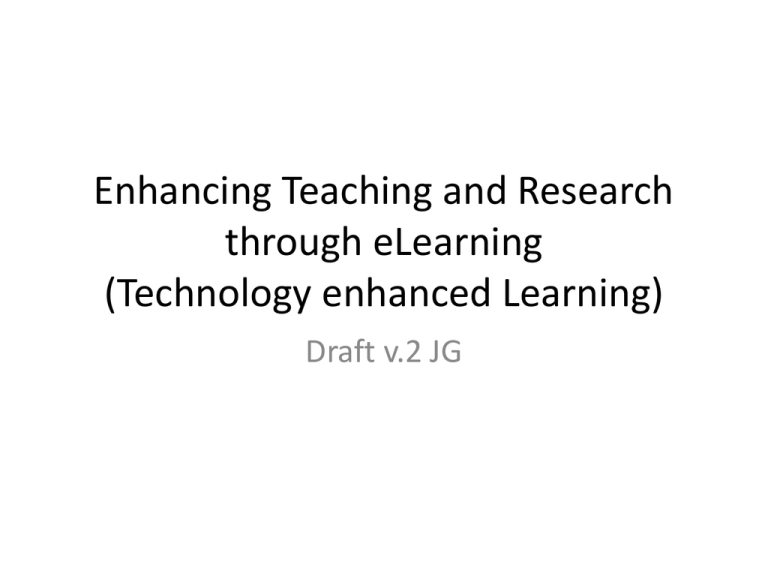
Enhancing Teaching and Research through eLearning (Technology enhanced Learning) Draft v.2 JG Outline Overview • • • • • Key challenges Current Situation Break out session – Discussion Effective eLearning Research led Teaching Key principles and Characteristics for successful policies Case Studies in Action Shared Challenges and Next Steps • Break out session - Discussion Overview – Current Situation, General challenges, effective eLearning, Research led Teaching Quality •Pedagogical approach •Research led teaching •Assessment based learning Global knowledge based economies Population Redesign of traditional courses Broaden Access Key Challenges Increased flexibility Remaining innovative and relevant Widen student engagement Cutting Cost Motivation for staff & students Adapting for creation of knowledge-based economies knowledgebased economies Life long learning HE Sector growing in scale Wider access to education Research Direct economic impact Improving social inclusion (HECTIC Report 2002) Different expectations motivations, skills and learning models The nature of a University? Growing demands Corporate Educational Providers Curricula frameworks Current Trends Lifelong Learning Qualification frameworks Globalisation Role of the University socially & economically Breakout session –What are the key challenges that universities are facing? –How far can they be addressed by elearning? –Some ideas about Teaching load Key principles and Characteristics for successful policies Elearning Technology enhanced learning …is the development and effective use of digital technologies to support learning, teaching and research Listen to an experienced elearning practitioner….Link to 2 minute podcast • Lots of different terms but they mean the same – Web-based training, computer-based training, web-based learning, and online learning supported learning blended / hybrid learning learning that occurs 100% online Quality Pedagogy first, technology second Legitistlative expectation Access Lifelong Learning Support cultural change Holistic Equal opportunities Socio Economic issues Reflect the existing ethos and learning approaches Sound instructional design principles Characteristics: effective eLearning Drivers for ELearning in Irish Universities Universities Ireland 2004 Sound Learning theories. Learnercentric Professional development & time out for staff Institutional support pedagogy + technology learning environments Deep learning principles Incentive & time for staff Research led teaching Software & hardware publications effective professional development Staff recognition Skill levels Quality Assurance Knowledge building & sharing Local support Tech. & pedagogy support Helping your staff Shared vision Successful elearning strategies (TCD) Institutional support Institutional support can significantly influence the outcome experience of staff in adopting innovation ...serve a critical role in ensuring the success of integrating technologies into teaching and learning and scholarly activities” (Howland, 2000) “High quality sustained and intensive staff development with an emphasis on developing the understanding of how people learn designing courses, teaching strategies, as well as building technology skills is essential” (Lim, 2001 & Rogers, 2001) Key principles for successful policy Ethos • Supporting independent learners • Flexibility • Student engagement • Diverse group of learners • Pedagogy + technology support integrated Organisation of eLearning Support Technologies & Platforms Strategies for Implementing ELearning Learning Level Knowledge Comprehension Application Analysis Reproduction Synthesis Evaluate Learning approach Surface Strategic Deep Learning activity Behavioural Scaffolded Constructivist Level of Autonomy Procedural Strategic Critical Delivery method Transmission Transaction Transformation Learning Outcomes define, describe, Identify, label, list, name, recall, write, match… translate, justify, defend, explain solve, use, modify, illustrate… assemble,plan, design, invent, create, judge, assess… ©Bruen & Kane, CLT, 2009 Linking Teaching and Research “No Issue more basic in modern education than the relationship between teaching and research” (Burton Clark, 1997) • Synergy will not happen by itself • Needs positive intervention Value of Linking teaching and Research • Experiential – A process which benefits students and staff • Conceptual – In terms of societal needs and the development and communication and knowledge • Operational – In terms of the potential reciprocity of teaching and research as learning activity (Zetter, 2002) Case Studies in Action •Dublin - Trinity College Dublin •Ireland - National Digital Learning Resources (NDLR) Services for Ireland •The World – Open Educational Resources (OER) Some examples from Trinity College School of Medicine School of Humanities Click here to view a virtual tour of the two projects … A National Solution to a National Problem…. Institutions trying to develop their own Teaching & Learning resources •Expense •Critical mass •Paucity of shared experiences •Difficult to sustain •Larger scale •More opportunity to support multiple subject areas •Potential for greater reuse A National Repository of •Potential for collaboration •Standing on the shoulder of giants shared Teaching & Learning Resources Raising the bar for teaching & learning as a collective 2004 - 2008 Where we are now…2010 An Open digital repository 2010 •Much more scalable •Huge potential for CoPs contribution & reuse •International license agreements already in place (e.g. Creative Commons licenses) - CCLearn •Protection against commercial exploitation •Easier to set up infrastructure (access & authentication not a problem) Academics perspective Institutional perspective Stakeholders Perspectives 1. Citation rates go up 1. 1. 2. Participating in a CoP (Self help network) Leveraging content more easily and safely Improving the quality of the teaching resources used within Irish HE 2. Exemplars to help employees to use & develop digital resources 2. 3. Encourages formation of self sustaining Cop & subject areas (academics using these resources) Enhancing the teaching practice associated with the use of digital learning via sharing of good practice and digital resources 3. Encourage reduction in the cost of teaching again via sharing and reuse… 3. More opportunities for feedback on your resources 4. More potential for collaborations 4. Potential for cost savings in the development of digital resources “to promote and support Higher Education academia in the collaboration, development and sharing of digital learning resources and associate teaching practices” Improve the availability and quality of the teaching resources Enhance the teaching practice associated with the use of digital learning Encourage a reduction in the cost of teaching via sharing and reuse of digital resources Click here to see how a Computer Science lecturer uses the NDLR to find resources Click here to see Veterinary bioenvironmental CoP resources NDLR User Support • 3 stage model Focus on content not courses OER support & Licensing Responsive Training programme & synergy events Portal Repository An Evolutionary Pathway to establish sustainable communities of academics Service team that is: Supportive Motivational Accessible Responsive Technologically Competent Sustainable NDLR academic communities Level 3 Encourage Sustainable Communities Level 2 Support collaborative Academics within Subject disciplines (LINCS) Institutional Projects Level 1 Support individual Academics Within Uni/IoT (LIPS) • • • • • Sustainable Manageable Active Relevant & Reflective Targeted Consideration of community is essential… Creative Commons •A movement that has evolved from open source software ideas and licences •Estb. 2001 by a group of American legal academics, creators and entrepreneurs •Generation of a number of easy-to-use licences so creators can share their work to the public while maintaining certain control over it •Now 55 million works using CC licences for their blog postings, RSS feeds, Wikis, Presenation, etc, etc. “Wanna Work Together?” What are Open Educational Resources? “digitised materials offered freely and openly for educators, students and self-learners to use and reuse for teaching, learning and research” Content • Full courses, courseware, content modules, learning objects, collections and journals Tools • Software to support the development, use, reuse and delivery of learning content Implementation Resources • Intellectual property licenses to promote open publishing of materials, design principles of best practice (OECD, 2007) Global examples OER for the general public YouTube Photo sharing through Flickr Vimeo Wikipedia Google Advanced Search Wikis How might OER be useful? • Identifying as a collective – Types of resources that are in use by staff and students in your institution on daily basis – Occasions and opprtunities for using Open Educational Resources Content • Full courses, courseware, content modules, learning objects, collections and journals Tools • Software to support the development, use, reuse and delivery of learning content Implementation Resources • Intellectual property licenses to promote open publishing of materials, design principles of best practice Shared Challenges and Next Steps Challenges and Opportunities 1. Making eLearning core to University Teaching and Learning 2. Improving eLearning Collaboration and Sharing within eLearning HE Sector 3. Researching and Improving educational quality of eLearning experience 4. Adoption of Standards and improve interoperability 5. Addressing eLearning Costs – – Resource requirements Academic (Staff) Development and skills acquisition (Universities Ireland 2004)
